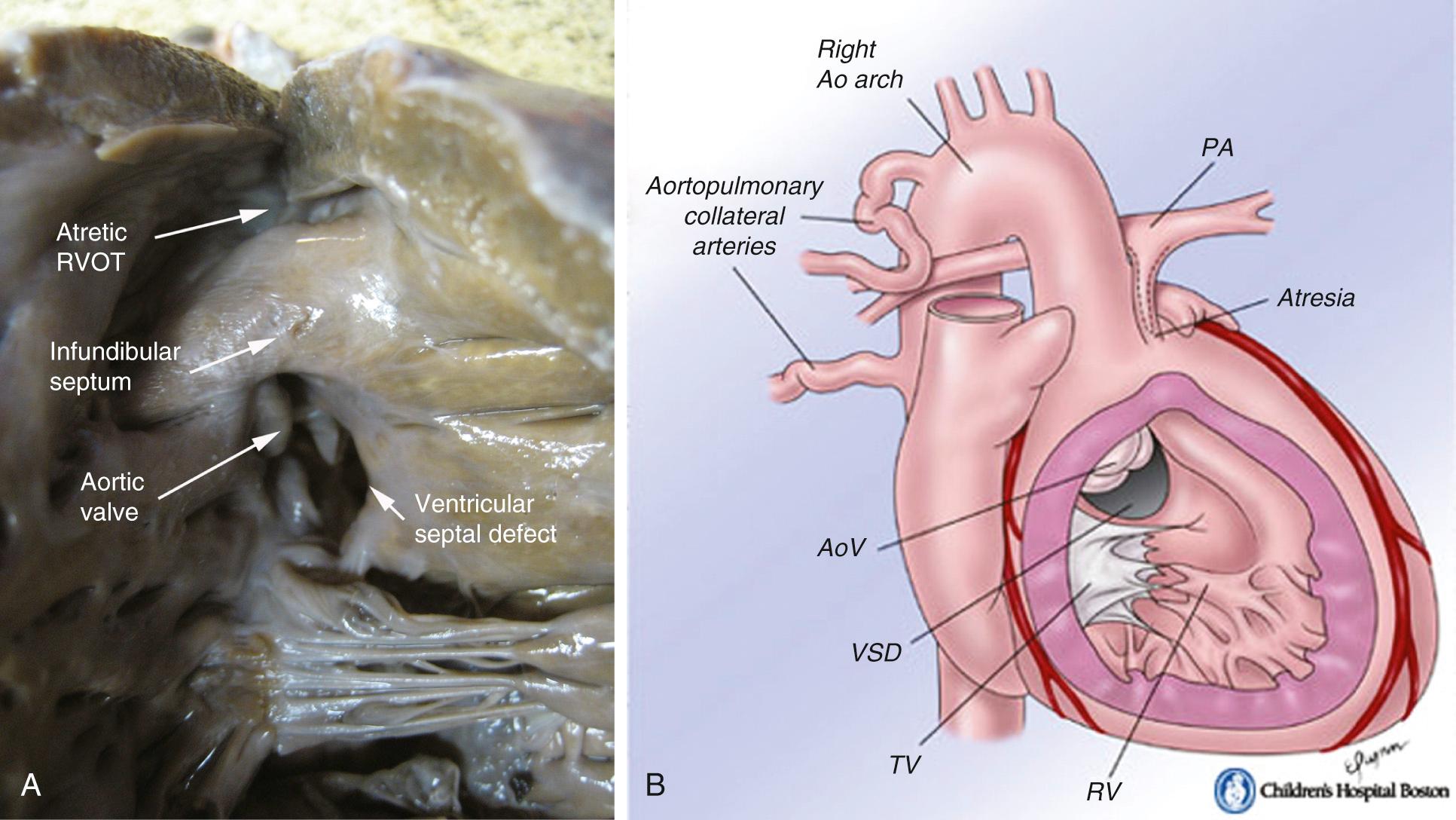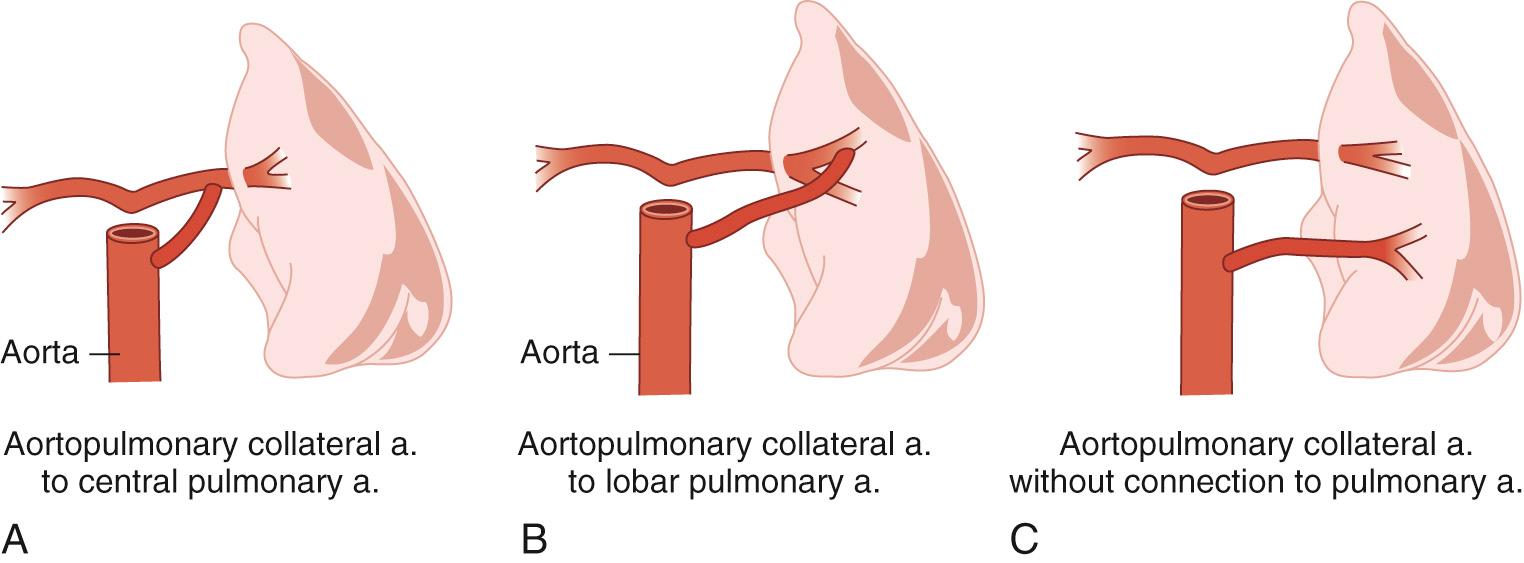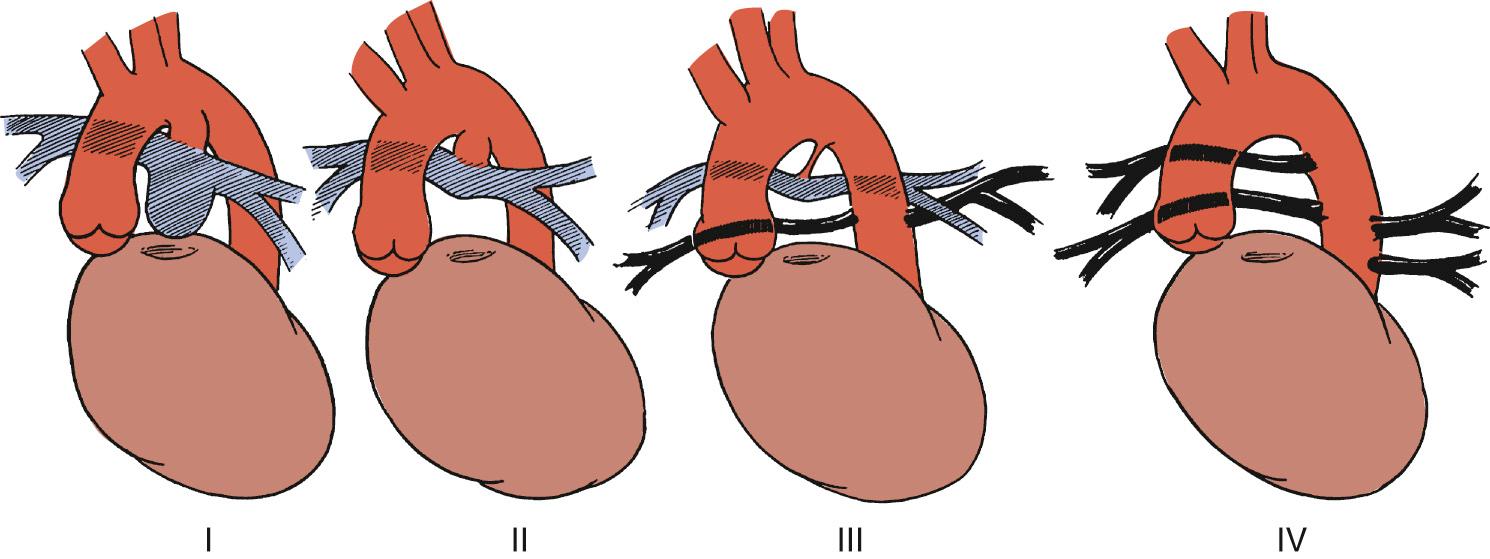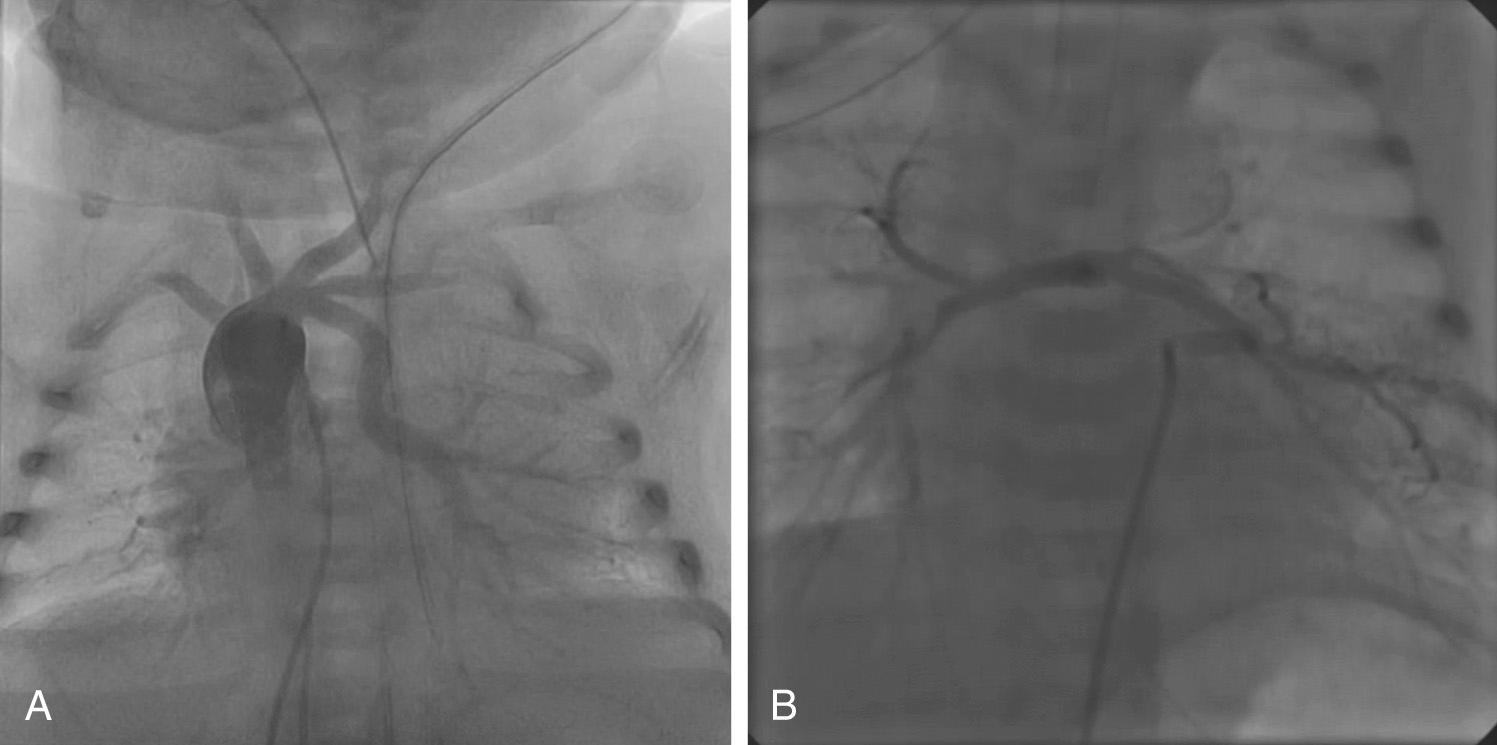Physical Address
304 North Cardinal St.
Dorchester Center, MA 02124
Pulmonary atresia with ventricular septal defect (PA/VSD) is a congenital cardiac malformation characterized by discontinuity of blood flow from the right ventricle to the pulmonary arteries, a ventricular septal defect (VSD) resulting from anterior deviation of the infundibular (conal) septum, and an overriding aorta. Because it shares many attributes of tetralogy of Fallot, it is also referred to as tetralogy of Fallot with pulmonary atresia. Incidence of PA/VSD is estimated to be 1 in 10,000 live births. A right aortic arch may be seen in up to 45% of patients. PA/VSD is also associated with major aortopulmonary collateral arteries (MAPCAs) that, in some cases, are the sole supply of pulmonary blood flow. The morphology of the pulmonary circulation, which varies significantly among patients, determines the management and prognosis of this malformation. PA/VSD may also be associated with other intracardiac defects, such as tricuspid atresia or stenosis, complete atrioventricular canal, complete or corrected transposition of the great arteries, left superior vena cava, anomalies of the coronary sinus, dextrocardia, and asplenia or polysplenia syndrome. These more complex forms of PA/VSD are not discussed in this chapter. The most common associated genetic defect is 22Q11 microdeletion, which is found in up to 34% of patients, and up to 65% of patients with MAPCAs are found to have this abnormality. Other phenotypic abnormalities with the 22Q11 microdeletion include submucosal cleft palate, abnormal facies, delayed development, and mental retardation. Neonates with trisomy 13 or 18 may have PA/VSD as well, and the prognosis is extremely poor for these children.
As in tetralogy of Fallot, PA/VSD is associated with anterior deviation of the infundibular septum, a conoventricular VSD, and the resulting aortic override ( Fig. 120-1 ). The spectrum of pulmonary atresia varies from purely valvular or subvalvular atresia (with intact main and branch pulmonary arteries) to complete absence of central pulmonary arteries. Pulmonary blood flow is dependent on the presence of an aortopulmonary communication, which may exist in the form of a patent ductus arteriosus (PDA), other major nonductal collaterals arising from the descending aorta that connect to the central native pulmonary arteries, or MAPCAs that directly enter the hilum and join the segmental pulmonary arteries. In utero, the pulmonary parenchyma is perfused by branches from the dorsal aorta as well as by the sixth aortic arch, which forms the basis for the central pulmonary arteries. Abnormal development of the central pulmonary arteries leads to persistence of the dorsal aortic branches, which ultimately develop into MAPCAs.

The lungs may be supplied by the native pulmonary arteries, by MAPCAs, or by both. If confluent central pulmonary arteries are present, the blood supply to the lung may arise from a PDA, a central “ductlike” collateral, or a MAPCA. The behaviors of these three sources of pulmonary blood flow differ in their predisposition to constrict over time, which has implications for the stability of pulmonary blood flow. Whereas MAPCAs or ductlike collaterals might remain patent beyond the neonatal period, the PDA is likely to constrict postnatally because of the presence of prostaglandin-responsive ductal tissue. Although the distinction may be difficult to establish by preoperative imaging studies, the location on the aorta from which the collateral originates is suggestive. A solitary collateral that arises just distal to the left subclavian artery (if left aortic arch) and travels to a central pulmonary confluence is likely to be a PDA, whereas a collateral that arises from any other location off the aorta and supplies a central confluence is termed a ductlike collateral. A vessel that exits the descending aorta and travels directly to the pulmonary parenchyma is likely a MAPCA. There may be heterogeneity in the sources of pulmonary blood flow within any given patient, such that one segment of lung may be supplied by the native pulmonary artery whereas another segment may be supplied by a MAPCA. Some segments may have a dual supply ( Fig. 120-2 ). Patients with confluent central pulmonary arteries that are supplied by a PDA are less likely to have significant MAPCAs, and those with nonconfluent central pulmonary arteries depend on MAPCAs for pulmonary blood flow.

There is no standard classification system for PA/VSD; however, several have been purported. Most classification schemes focus on the patterns of pulmonary blood flow. The classification system adopted by the Congenital Heart Surgery Nomenclature Project broadly divides pulmonary artery anatomy according to the following: central pulmonary arteries without MAPCAs, confluent central pulmonary arteries and dual supply with MAPCA, nonconfluent or absent central pulmonary arteries with MAPCA.
Another classification scheme divides patients further according to specific patterns of pulmonary artery anatomy that are most commonly encountered ( Fig. 120-3 ):
Valvar pulmonary atresia with a decent-sized main pulmonary artery and confluent central pulmonary arteries. This variant is associated with a PDA and therefore not associated with MAPCAs.
Absent main pulmonary artery with confluent, decent-sized or mildly hypoplastic central pulmonary arteries supplied by a PDA, without MAPCAs.
Confluent central pulmonary arteries with MAPCAs but no PDA.
Central pulmonary artery z-score > −2.5
Central pulmonary artery z-score < −2.5
Nonconfluent or absent central pulmonary arteries with MAPCAs.
Nonconfluent central pulmonary artery with PDA and MAPCAs.

The natural history of PA/VSD varies significantly depending on the pulmonary artery morphology. Patients presenting with PA/VSD that has ductal dependent pulmonary blood flow will experience profound fatal cyanosis in the neonatal period as the ductus begins to close. On the other hand, patients with MAPCAs with mild stenosis of collateral vessels and balanced pulmonary blood flow exhibit mild cyanosis and may survive into adolescence or adulthood without repair. Progressive development of ostial stenosis within the collateral leads to progressive cyanosis. Alternatively, excessive pulmonary blood flow from an unrestrictive collateral results in congestive heart failure. The presence of long-standing unrestrictive blood flow within a MAPCA may result in irreversible elevation of pulmonary vascular resistance within that segment. Pulmonary hypertension within a segment of the lung is seen commonly in patients who present at later age. Heterogeneity in pulmonary vascular resistance within a lung segment results in  mismatch. Without timely intervention, the overall mortality rate is approximately 60% by 30 years of age, with most of the mortality occurring within the first year of life.
mismatch. Without timely intervention, the overall mortality rate is approximately 60% by 30 years of age, with most of the mortality occurring within the first year of life.
The clinical presentation varies according to pulmonary artery morphology. Patients with ductal-dependent pulmonary circulation present with profound cyanosis during the first several weeks of life as the ductus begins to close. Children with progressively restrictive aortopulmonary collaterals may present in childhood with cyanosis, whereas patients with large, unrestrictive collaterals may present with heart failure symptoms such as failure to thrive, tachypnea, or feeding intolerance. Among infants presenting during infancy, 50% present with cyanosis and 25% present with heart failure symptoms. Rarely, in a child with balanced pulmonary blood flow, symptoms may not manifest until adolescence or adulthood.
In the current era, prenatal diagnosis is frequently established by fetal ultrasound and echocardiography by the demonstration of absence of antegrade pulmonary artery blood flow. A neonate presenting with cyanosis following ductal closure may demonstrate hypovascular lung fields by chest radiography, whereas an infant presenting with excessive pulmonary blood flow and congestive heart failure may demonstrate interstitial edema and prominent hilar vessels. A right-sided aortic arch may be demonstrated by the position of the aortic knob by chest x-ray, and the diminutive main pulmonary artery results in an exaggerated sabot shape of the cardiac silhouette. By electrocardiography, rightward deviated QRS axis and evidence of right atrial and ventricular hypertrophy are frequently seen.
Echocardiography is the primary modality for diagnosis of this defect, and it provides a significant portion of the anatomic information needed for initial decision making in neonates and infants. The data to be obtained by echocardiography include location, size, and direction of flow in the ventricular and atrial septal defects; size and confluence of the central pulmonary vessels; and presence of a PDA or other collaterals. Color flow Doppler may suggest the presence of a collateral arising from the descending aorta, but it is not reliable at delineating the entire course. Retrograde flow in the descending aorta suggests significant pulmonary flow through the collateral or PDA. Coronary artery anatomy should be delineated, particularly to exclude the presence of a left anterior descending coronary artery arising from the right coronary artery, because this impacts surgical management.
Cardiac catheterization is indicated in patients with PA/VSD who have nonconfluent or hypoplastic central pulmonary arteries in whom MAPCAs are suspected ( Fig. 120-4 ). The goal of catheterization in these patients is surgical planning by evaluating the anatomy, size, degree of stenosis, and the presence of dual supply from native pulmonary arteries or collaterals. Vascular supply to all segments must be clearly determined. Native pulmonary arteries may require visualization by pulmonary venous wedge injection if no antegrade flow to the native pulmonary arteries can be identified. Relationship of collaterals to the airway (seen best on the lateral view) is important in guiding surgical approach (sternotomy vs. thoracotomy). In older children and adults, measurements of individual pulmonary artery pressures are obtained to determine the risk of development of pulmonary hypertension in high-pressure collaterals. The pulmonary-to-systemic blood flow ratio (Qp/Qs) can be estimated by the Fick method if all pulmonary flow arises from collaterals (i.e., if there is no previous right ventricle–to–pulmonary artery [RV-to-PA] conduit). Interventions that may be performed at catheterization include balloon dilation of native pulmonary vessels, stenting of highly restrictive MAPCAs, or coiling of redundant dual-supply collaterals.

Cardiac catheterization is rarely indicated for types I or II PA/VSD with normal-sized central confluent pulmonary arteries demonstrated by echocardiogram, because the risk of collaterals is low and surgical management is complete repair. Exceptions include patients at high risk for surgical management, in whom catheter-based intervention (stenting of PDA or right ventricular outflow tract [RVOT]) is contemplated.
Magnetic resonance imaging (MRI) is a useful adjunct to cardiac catheterization in patients with MAPCAs. The advantage of MRI is its ability to image native pulmonary arteries that may not be accessible by cardiac catheterization. It is superior to other imaging modalities at delineating the relationship of MAPCAs to other mediastinal structures (airway, esophagus). MRI is used to estimate right ventricular volumes and conduit regurgitation fraction in completely repaired patients and guides decision making regarding conduit replacement.
In patients with stenosis of pulmonary arteries (within collaterals or following unifocalization), decreased blood flow to specific segments of lung may portend irreversible vascular occlusion. Segmental malperfusion detected by lung perfusion scanning can be used to screen patients for the presence of significant stenoses of the native pulmonary arteries or MAPCAs. A heterogenous perfusion pattern may indicate that certain segments are under high pressure and others are underperfused. Progressive reduction in segmental lung perfusion prompts cardiac catheterization and intervention to prevent irreversible vascular occlusion.
In a neonate with PDA-dependent pulmonary blood flow, prostaglandins are infused at 0.01 to 0.1 µg/kg/min to maintain ductal patency and preserve pulmonary blood flow. Preoperative mechanical ventilation is not necessary and may even be detrimental if it lowers the PVR and increases the left-to-right shunt. Diuretics may be used for patients with heart failure symptoms.
The ultimate goal of the surgical repair strategy is creation of biventricular circulation with unobstructed RV-to-PA continuity and elimination of intracardiac or extracardiac shunts with low resultant right ventricular pressure. To attain this goal, the VSD must be closed and branch and segmental vasculature must be recruited, and vascular caliber must be maximized to minimize pulmonary resistance. Generally, the repair strategy centers on optimizing pulmonary artery recruitment and thus varies depending on native pulmonary artery morphology and collateral supply.
If the central pulmonary arteries are confluent and normal in caliber, a PDA is usually present. Complete repair in the neonatal period consists of reconstituting RV-to-PA continuity, ligation of the PDA, and VSD closure. In most patients, RV-to-PA continuity is established with a valved conduit (see Right Ventricle–to–Pulmonary Artery Conduit section). In patients with purely valvular atresia who have a patent main pulmonary artery segment, a transannular patch may be associated with longer freedom from reintervention compared to an RV-to-PA conduit. However, this approach may be associated with longer postoperative recovery and cyanosis related to a noncompliant right ventricle. Conversion to RV-to-PA conduit may become necessary in a subset of these patients.
Some centers prefer to perform a palliative systemic artery–to–pulmonary artery or RV-to-PA shunt in neonates, followed by complete repair later in infancy. This strategy minimizes the potential morbidity of neonatal repair and promotes growth of the central pulmonary arteries but places the patient at risk for shunt thrombosis, which can be fatal if the ductus is closed. Shunting as the initial procedure has been identified as a risk factor for early mortality in several retrospective series.
Transcatheter procedures such as radiofrequency perforation or ductal stenting are palliative alternatives to complete repair. Radiofrequency perforation of membrane-like atresia of the pulmonary valve combined with balloon dilation or stenting of the outflow tract can delay complete repair for 2 to 4 months. Stenting of PDA maintains stable blood flow in a neonate with confluent central pulmonary arteries following discontinuation of prostaglandins and promotes vascular growth. Stent implantation is hampered by tortuosity of the PDA. Stent migration, embolization, and restenosis have been reported. Given the low mortality of neonatal complete repair, palliation may be most appropriate for high-risk patients (genetic abnormalities, intracranial hemorrhage, pulmonary disease).
In patients with dimunitive central pulmonary arteries, simple VSD closure and RV-to-PA conduit would lead to elevated right ventricular pressure because of small vascular caliber, segmental vascular discontinuity, and accessory collateral supply. Delineation of branch pulmonary artery anatomy and collateral supply by cardiac catheterization is imperative in guiding the reconstructive strategy. If native central and branch pulmonary arteries are simply diminutive yet demonstrate continuity with all lung segments, initial intervention to promote growth of the central native pulmonary artery can be followed by eventual complete repair. Central pulmonary artery growth in this setting is stimulated by providing antegrade blood flow via either an aortopulmonary shunt or a restrictive RV-to-PA conduit and elimination of redundant collateral supply. There are several advantages of an RV-to-PA conduit over aortopulmonary shunt for this indication. Transcatheter access to the branch pulmonary arteries for sequential dilation is much easier through an RV-to-PA conduit than through an aortopulmonary shunt. Particularly in older infants, the use of an RV-to-PA conduit may be superior to an aortopulmonary shunt in promoting growth of native pulmonary arteries.
Aortopulmonary collaterals that are discontinuous with central pulmonary arteries may provide the sole supply to significant segments of lung. Recruitment of these collaterals into the central pulmonary artery segment is essential to ensure low right ventricular pressures and optimize  matching. Unifocalization refers to the technique by which collaterals are disconnected from the aorta and anastomosed to a common confluence that can receive blood supply from a stable source—usually an RV-to-PA conduit or aortopulmonary shunt. If the collaterals are accessible from an anterior approach, unifocalization at the time of shunting or RV-to-PA conduit placement is performed by end-to-side anastomosis.
matching. Unifocalization refers to the technique by which collaterals are disconnected from the aorta and anastomosed to a common confluence that can receive blood supply from a stable source—usually an RV-to-PA conduit or aortopulmonary shunt. If the collaterals are accessible from an anterior approach, unifocalization at the time of shunting or RV-to-PA conduit placement is performed by end-to-side anastomosis.
Anastomotic stenosis at the site of unifocalization requires transcatheter intervention to avoid loss of segmental blood flow in approximately 50% of patients at 5 years. High rate of collateral occlusion or stenosis has prompted some groups to pursue rehabilitation of hypoplastic native pulmonary arteries by a neonatal shunting regimen alone, without collateral unifocalization in select patients with dimunitive central pulmonary arteries and MAPCAs.
Once growth of the central and branch pulmonary arteries is achieved, closure of the VSD with an unrestrictive RV-to-PA conduit can be performed. Nuances regarding the timing and technical aspects of VSD closure are discussed later in this chapter (see Closure of Ventricular Septal Defect section).
Become a Clinical Tree membership for Full access and enjoy Unlimited articles
If you are a member. Log in here